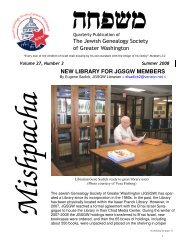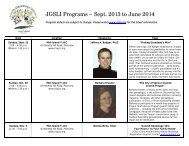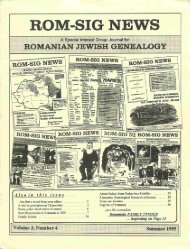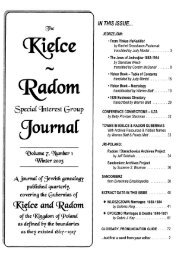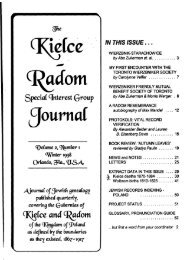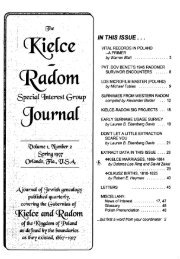THE MEMORIAL BOOK OF PÁPA JEWRY - JewishGen
THE MEMORIAL BOOK OF PÁPA JEWRY - JewishGen
THE MEMORIAL BOOK OF PÁPA JEWRY - JewishGen
Create successful ePaper yourself
Turn your PDF publications into a flip-book with our unique Google optimized e-Paper software.
A third teacher, Lipót Ehrenfeld, was also a brave fighter for the idea of Hungarian<br />
liberty: he was dispatched to the river Drava to help crush the rebellious minority nationalities.<br />
The innovative ideas of Lipót Lőw failed to succeed, so most parents chose not to enroll<br />
their children at the public school, opting for a private school instead, until government<br />
commissioner, Antal Hunkár, closed down the private schools. After the defeat of the Hungarian<br />
War of Independence, the Bach-era set new directions for the school as well. The Governor’s<br />
Council in Sopron ordered the school to be reorganized. Specialization was introduced. Teachers<br />
were usually employed for only one semester. The language of instruction could have been<br />
German, with the syllabus basically supplied by the Austrian curriculum. School fees depended<br />
on the parents’ financial situation and ranged from 12 kreuzers to 2 forints, determined by the<br />
community officials.<br />
A new period in the life of the school began with the 1859/60 school year. From this point<br />
on, the practice of employing teachers for only one term stopped. Instead, teachers were<br />
employed for three years and after a period of probation, they received tenure.<br />
The Hungarian language regained its<br />
previous status. In 1863 an alternating system was<br />
introduced, according to which the teacher (formmaster)<br />
stayed with his class from the first grade<br />
until the fifth grade. Samuel Horovitz, N. Spatz, and<br />
Fülöp Klein were teachers of this period.<br />
From 1875 to 1880, there were two Jewish<br />
public schools in Pápa belonging to the two Jewish<br />
communities. When the two communities united,<br />
the orthodox school took over the teachers from the<br />
other school. This is how Ármin Schor, Mór<br />
Öszterreicher, and Franciska Reiner née Rosenthal<br />
got to the schools of the főhitközség, the head<br />
community, as it was called then.<br />
Apart from the elementary school, the need<br />
for a secondary school had long been felt by the<br />
Pápa community. This was shown by the first<br />
attempt in 1878, at the initiative of chief rabbi Dr.<br />
Breuer, to create a Jewish reáliskola, a secondary<br />
school for modern languages and sciences. In the<br />
school year 1878/79 they opened first grade, which<br />
had 47 pupils, of which one was Roman Catholic.<br />
Antal Csemegi, Kálmán Vikár, and Ármin Schor<br />
36<br />
Dayan and religious education teacher<br />
Hermann Eckstein<br />
were the teachers. The community could not support the costs of the secondary school so after a<br />
year of the experiment the school closed down.<br />
On August 15, 1899, the school board discussed the initiative by Lipót Buxbaum, who<br />
"came up with the idea of founding a denominational higher elementary school in the local<br />
Jewish community"(polgári iskola). Chairman of the school board, József Steiner, made a fine<br />
speech supporting the realization of the idea. On August 20, 1899, the board of Pápa Autonomous



